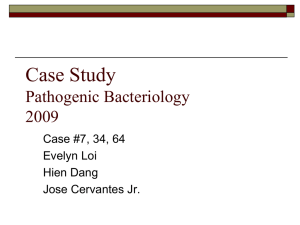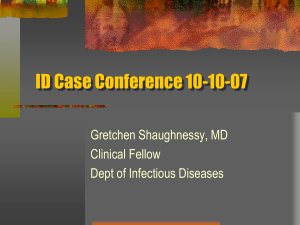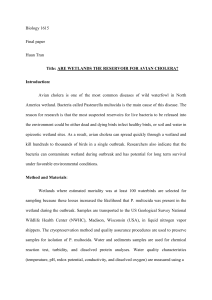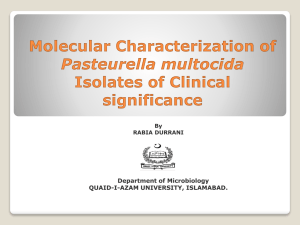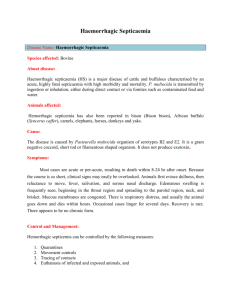Conventional and molecular differentiation between capsular types of Pasteurella multocida isolated from various animal hosts
advertisement
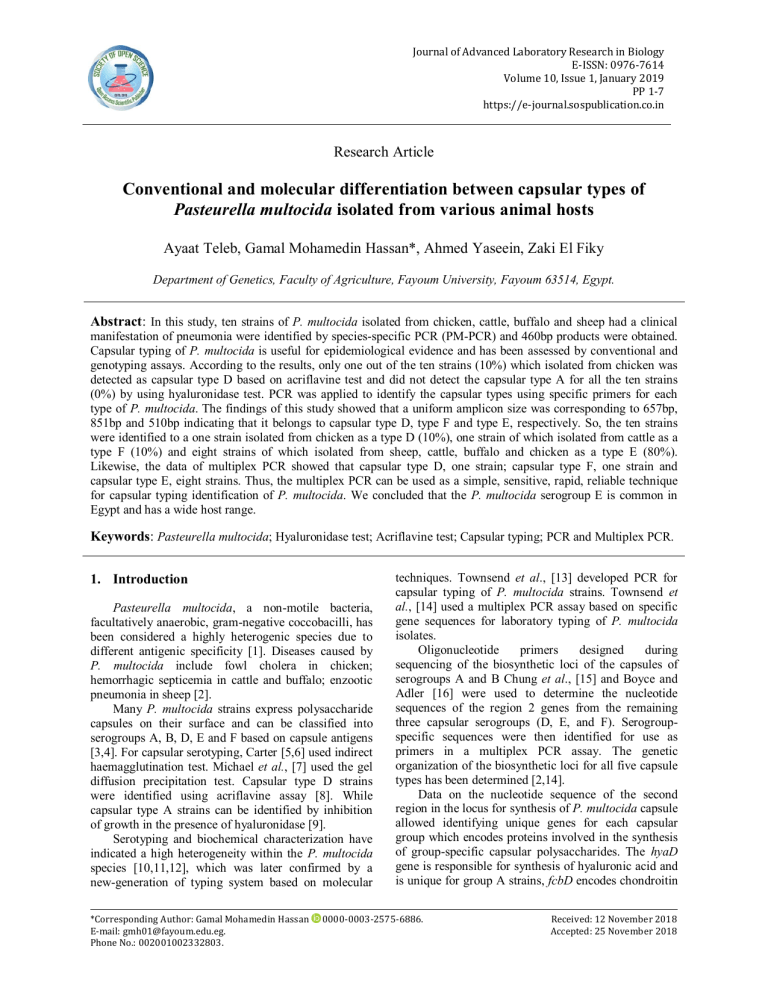
Journal of Advanced Laboratory Research in Biology E-ISSN: 0976-7614 Volume 10, Issue 1, January 2019 PP 1-7 https://e-journal.sospublication.co.in Research Article Conventional and molecular differentiation between capsular types of Pasteurella multocida isolated from various animal hosts Ayaat Teleb, Gamal Mohamedin Hassan*, Ahmed Yaseein, Zaki El Fiky Department of Genetics, Faculty of Agriculture, Fayoum University, Fayoum 63514, Egypt. Abstract: In this study, ten strains of P. multocida isolated from chicken, cattle, buffalo and sheep had a clinical manifestation of pneumonia were identified by species-specific PCR (PM-PCR) and 460bp products were obtained. Capsular typing of P. multocida is useful for epidemiological evidence and has been assessed by conventional and genotyping assays. According to the results, only one out of the ten strains (10%) which isolated from chicken was detected as capsular type D based on acriflavine test and did not detect the capsular type A for all the ten strains (0%) by using hyaluronidase test. PCR was applied to identify the capsular types using specific primers for each type of P. multocida. The findings of this study showed that a uniform amplicon size was corresponding to 657bp, 851bp and 510bp indicating that it belongs to capsular type D, type F and type E, respectively. So, the ten strains were identified to a one strain isolated from chicken as a type D (10%), one strain of which isolated from cattle as a type F (10%) and eight strains of which isolated from sheep, cattle, buffalo and chicken as a type E (80%). Likewise, the data of multiplex PCR showed that capsular type D, one strain; capsular type F, one strain and capsular type E, eight strains. Thus, the multiplex PCR can be used as a simple, sensitive, rapid, reliable technique for capsular typing identification of P. multocida. We concluded that the P. multocida serogroup E is common in Egypt and has a wide host range. Keywords: Pasteurella multocida; Hyaluronidase test; Acriflavine test; Capsular typing; PCR and Multiplex PCR. 1. Introduction Pasteurella multocida, a non-motile bacteria, facultatively anaerobic, gram-negative coccobacilli, has been considered a highly heterogenic species due to different antigenic specificity [1]. Diseases caused by P. multocida include fowl cholera in chicken; hemorrhagic septicemia in cattle and buffalo; enzootic pneumonia in sheep [2]. Many P. multocida strains express polysaccharide capsules on their surface and can be classified into serogroups A, B, D, E and F based on capsule antigens [3,4]. For capsular serotyping, Carter [5,6] used indirect haemagglutination test. Michael et al., [7] used the gel diffusion precipitation test. Capsular type D strains were identified using acriflavine assay [8]. While capsular type A strains can be identified by inhibition of growth in the presence of hyaluronidase [9]. Serotyping and biochemical characterization have indicated a high heterogeneity within the P. multocida species [10,11,12], which was later confirmed by a new-generation of typing system based on molecular *Corresponding Author: Gamal Mohamedin Hassan E-mail: gmh01@fayoum.edu.eg. Phone No.: 002001002332803. techniques. Townsend et al., [13] developed PCR for capsular typing of P. multocida strains. Townsend et al., [14] used a multiplex PCR assay based on specific gene sequences for laboratory typing of P. multocida isolates. Oligonucleotide primers designed during sequencing of the biosynthetic loci of the capsules of serogroups A and B Chung et al., [15] and Boyce and Adler [16] were used to determine the nucleotide sequences of the region 2 genes from the remaining three capsular serogroups (D, E, and F). Serogroupspecific sequences were then identified for use as primers in a multiplex PCR assay. The genetic organization of the biosynthetic loci for all five capsule types has been determined [2,14]. Data on the nucleotide sequence of the second region in the locus for synthesis of P. multocida capsule allowed identifying unique genes for each capsular group which encodes proteins involved in the synthesis of group-specific capsular polysaccharides. The hyaD gene is responsible for synthesis of hyaluronic acid and is unique for group A strains, fcbD encodes chondroitin 0000-0003-2575-6886. Received: 12 November 2018 Accepted: 25 November 2018 Capsular typing of Pasteurella multocida synthase in group F, dcbF is responsible for synthesis of heparan glycoside in D. Genes bcbD and ecbJ encode glycosyltransferase in strains of capsular groups B and E, respectively. Also, cell wall protein gene KMT1 highly conserved and unique for the P. multocida is identified [14]. The elucidation of the genetic basis for capsule biosynthesis has facilitated the development of a muchimproved method for laboratory typing of P. multocida isolates utilizing a multiplex PCR assay based on specific gene sequences [14]. Capsular genotyping was conducted based on amplification of 5 different capsular groups using multiplex PCR in the presence of each capsule specific primer along with P. multocida specific primers by Shayegh et al., [17] and Ihab et al., [18]. The PCR-based typing method has therefore supplanted the previously conventional serotyping [19,20,21] and is now used extensively worldwide as accurate standard. Although the limitation of conventional serological or non-serological methods for capsular typing of P. multocida most laboratories still used this method. The objectives of this study were to apply the conventional methods and PCR protocols for the identification of the hyaD-hyaC, bcbD, dcbF, ecbJ and fcbD genes specific to capsular types A, B, D, E and F, respectively on p. multocida strains, and to determine the relationship between animal host and capsular type of P. multocida strains based on molecular capsular typing methods. 2. Material and Methods 2.1 Bacterial strains and growth conditions Ten strains of P. multocida were used in this study. Some phenotypic and molecular characters of the five of P. multocida strains isolated from sheep, buffalo and cattle have been described previously [22] where another five strains isolated from chicken were kindly provided by Prof. Dr. Selim Salama Selim, Professor of Microbiology and Immunology, ARC, Egypt. P. multocida were grown in Brain Heart Infusion (BHI) Broth and Blood agar (BA) plates. The cultures were stored at 4°C and subcultured monthly. 2.2 Genomic DNA extraction from P. multocida strains Genomic DNA of the ten P. multocida strains was extracted following the method described by Tillett and Neilan [23]. The purity and the concentration of DNA were estimated by spectrophotometry at 260 and 280nm. 2.3 Molecular confirmation of bacterial strains by species-specific PCR (PM-PCR) The species-specific primers KMT1T7 and KMT1SP6 designed by Townsend et al., [13], FATCCGCTATTTACCCAGTGG and RGCTGTAAACGAACTCGCCAC were used to amplify J. Adv. Lab. Res. Biol. (E-ISSN: 0976-7614) - Volume 10│Issue 1│2019 Hassan et al the KMT1 gene sequence in P. multocida. The PCR reaction was performed in the thermal cycler 2720 (Applied Biosystems, USA) in a total volume of 25μl containing 3μl of template DNA (50ng/l), 1μl of each primer, 12.5μl of 1x PCR master mix (GeneDireX) and 7.5μL of DNase free water. The amplification program consisted of an initial denaturation step at 95°C for 5 min followed by 30 cycles of 30 sec denaturation at 94°C, 30 sec primer annealing at 50°C, 1 min extension at 72°C and a final extension of 10 min at 72°C. 2.4 Conventional capsular typing of P. multocida Two aliquots of a BHI overnight culture were selected for the identification of serogroup D strains with the acriflavine test and for identification of serogroup A strains with the hyaluronidase test according to Carter and Subronto [8] and Carter and Rundell [9], respectively. Hyaluronic acid is the main chemical component of the capsular type A structure, If there was a diminution in the size of the P. multocida colonies in the region adjacent to the Staphylococcus streak, the isolate was assigned to serotype A. Serotype D was determined by the characteristic flocculation with acriflavine neutral (0.1%, Sigma, USA). If an isolate gave flocculation at the bottom of the test tube, then the isolate was assigned to serotype D. 2.5 Capsular typing via single and multiplex polymerase chain reaction The separate singleplex PCR was used according to the method described by Townsend et al., [14] using a specific pair of primers for each capA, capB, capE, capD or capF (Table 1). The PCR mix consisted of 12.5μL of 1X PCR master mix (GeneDireX), 3μL of template DNA (50ng/l), 1μL of each primer and sterile deionized water for a final volume of 25μL. Amplification was performed in a thermal cycler 2720 (Applied Biosystems, USA) under the following reaction conditions: initial denaturation (95°C for 5 min) followed by 30 cycles of denaturation (95°C for 30 sec), annealing (50°C, 45°C, 42°C, 40°C and 45°C for 30 seconds) for capA, capB, capE, capD and capF respectively, and elongation (72°C for 60 sec) and a final elongation stage (72°C for 10 min). The multiplex-PCR was used according to the technique described by Townsend et al., [14] using 3 specific primer pairs for E, D and F capsular type (Table 1). PCR mix consisted of 12.5μl of 1X PCR master mix (GeneDireX), 3μl of template DNA (50ng/l), 1μl of each primer and sterile deionized water for a final volume of 25μl. Amplification was performed in the thermal cycler 2720 (Applied Biosystems, USA) under the following reaction conditions: initial denaturation at 94ºC for 5 min followed by 30 cycles of denaturation (95ºC for 30 sec), annealing (42ºC for 30 sec), extension (72ºC for 30 sec) and a final extension step of 72ºC for 10 min. Page | 2 Hassan et al Capsular typing of Pasteurella multocida Table 1. The sequence of primers that used in PCR and multiplex PCR capsular typing of P. multocida strains. Serogroup Gene Primer Primer sequence 5'-3' Amplicons (bp) A hyaD-hyaC capA-F capA-R GATGCCAAAATCGCAGTCAG TGTTGCCATCATTGTCAGTG 1044 B bcbD capB-F capB-R CATTTATCCAAGCTCCACC GCCCGAGAGTTTCAATCC 760 D dcbF E ecbJ F fcbD capD-F capD-R capE-F capE-R capF-F capF-R TTACAAAAGAAAGACTAGGAGCCC CATCTACCCACTCAACCATATCAG TCCGCAGAAAATTATTGACTC GCTTGCTGCTTGATTTTGTC AATCGGAGAACGCAGAAATCAG TTCCGCCGTCAATTACTCTG 2.6 Agarose gel electrophoresis All PCR products were analyzed using electrophoresis on a 1.2% agarose gel which stained with 2μl ethidium bromide (0.5μg/ml) and run at 90 V for 45 minutes. A 5μl of the DNA ladder 100bp (BioTeke Corporation) was used as marker and the gel was viewed under UV transilluminator. 3. Results and Discussion 3.1. Confirmation of bacterial strains by speciesspecific PCR (pm-PCR) assay The presence of a DNA band approximately 460bp in size (amplification of a specific fragment of the KMT1 gene) in all strains confirmed the identification of all strains as P. multocida (Fig. 1). The results of previous studies [13,24,25,26] using primers KMT1T7 and KMT1SP6 in agreement with these results. The PCR assay was shown to be species-specific, providing a valuable supplement to phenotypic identification of species within this group of bacteria [27]. Species- 657 511 850 specific PCR (PM-PCR) assay was a suitable technique for specific detection of P. multocida. 3.2. Capsular typing by conventional methods Capsular typing of P. multocida is useful for epidemiological evidence and has been assessed by conventional and genotyping assays. Fig. (2) show the results of acriflavine test, only one out of the ten strains (10%) which isolated from chicken was detected as capsular type D. The result of capsular typing by using hyaluronidase test did not detect the capsular type A for all the ten strains (Fig. 3). Conventionally, an indirect haemagglutination test (IHA) for typing of specific capsule antigens was described [5]. To overcome the difficulties with IHA test, non-serologic tests were designed for recognition of types A [9], D [8] and F [28]. Hyaluronic acid is the main chemical component of the capsular type A structure, those colonies exhibiting growth inhibition in close proximity to the S. aureus streak were assigned to serogroup A [28]. Arumugam et al., [19] identified capsular types A, B and D as the common capsular types among 114 P. multocida isolates in Malaysia. Fig. 1. PCR amplification of KMT1 gene for identification of P. multocida strains. Lane M: 100bp DNA Ladder, Lanes 1-10: ten P. multocida strains. J. Adv. Lab. Res. Biol. (E-ISSN: 0976-7614) - Volume 10│Issue 1│2019 Page | 3 Capsular typing of Pasteurella multocida Hassan et al Fig. 2. Acriflavine test: (A) negative reaction. (B) Positive reaction between the inoculum of P. multocida type D and acriflavine solution. Fig. 3. Hyaluronidase test: colonies of P. multocida lack growth inhibition in the vicinity of the staphylococcal colony. 3.3. Molecular capsular typing PCR was applied to confirm the capsular typing using specific primers for each type. The findings of this study in Fig. (4) showed that a uniform amplicon size corresponding to 657bp, 851bp and 510bp indicating that it belongs to capsular type D (one strain which isolated from chicken), Type F (one strain which isolated from cattle) and type E (eight strains which isolated from sheep, cattle, buffalo and chicken), respectively (Table 2). Likewise, the data of multiplex PCR showed that one strain (10%) was detected as capsular type D and one strain (10%) was detected as capsular type F and eight out of ten bacterial strains (80%) were classified into capsular type E (Fig. 5 and Table 2). On the other hand, no strains gave any amplification with either the capsular type A or B. The capsular typing using PCR was successfully optimized and applied to confirm the capsular types of P. multocida. Multiplex PCR is an alternative to comparative conventional tests for the identification of capsular P. multocida because it allows for the J. Adv. Lab. Res. Biol. (E-ISSN: 0976-7614) - Volume 10│Issue 1│2019 simultaneous, rapid detection of genes and provides a greater capacity for strain typing. The conventional methods used in this study were failed to identify the serogroups E and F whereas, all strains were initially tested with the multiplex PCR that involved identification at the species level and then assignment to serogroups D, E and F. These findings are in agreement with Shivachandra et al., [29] they found that a 16% of 123 isolates from different avian species were not identified by conventional tests, whereas all samples were typed by multiplex PCR. Similarly, Arumugam et al., [19] found that 48% of strains were nontypeable strains with the hyaluronidase and acriflavine test or through the use of specific antisera to identify the capsule types A, D and B, respectively. Diverging classifications for these two methodologies have been noted in other studies [30,19]. Table (2) show the serogroup D obtained from chicken (1/5); serogroup E obtained from sheep (1/1), from buffalo (2/2), from cattle (1/2) and from chicken (4/5) and serogroup F obtained from cattle (1/2). These results suggested that the serogroup E is common in Page | 4 Hassan et al Capsular typing of Pasteurella multocida Egypt and has a wide range of host. Whereas, the results of previous studies have shown that capsular types A and D are common among isolates recovered from sheep and goats [31,32,33 ]. Differing frequencies of P. multocida serotypes have been observed in other studies. Values for P. multocida serotype D vary from 0% in rabbits in Brazil [34] to 82.6% in cattle in India and South Asia [35]. Similar results were obtained with P. multocida serotype A, which exhibit a prevalence ranging from 17.4% in cattle [35] to 95.24% in geese in Hungary [36]. These differences between serotypes of P. multocida may be due to several factors, including the prevalence of the microorganism in the breed and processing techniques. The ability of P. multocida to invade and multiply within the host is enhanced by the presence of its capsule, a polysaccharide structure that is one of the most important virulence factors for this species [37]. Additionally, there are conflicting reports in the literature regarding the possible role of capsule in the adhesion to host cells and tissues [38]. The importance of the capsule in P. multocida adherence possibly depends on its strain and host cell type [39]. Table 2. The relationship between animal host and capsular type of 10 P. multocida strains based on molecular capsular typing methods. Strain 1 2 3 4 5 6 7 8 9 10 Host Sheep Buffalo Buffalo Cattle Cattle Chicken Chicken Chicken Chicken Chicken Total Serogroup E E E E F E E E E D E D F Genotype frequency 1/1 (100%) 2/2 (100%) 1/2 (50%) 1/2 (50%) 4/5 (80%) 1/5 (20%) 8/10 (80% 1/10 (10%) 1/10 (10%) 4. Conclusion We concluded that the multiplex PCR assay represents a rapid and reproducible alternative compared to conventional capsular typing currently used for the classification of P. multocida. The serogroup E of P. multocida is common in Egypt and has a wide host range. Fig. 4. PCR amplification of fcbD, dcbF, ecbJ, (hyaD-hyaC) and bcbD genes for detection capsular types: F, D, E, A and B, respectively. Lane M: 100bp DNA Ladder, Lane 1-10: ten P. multocida strains. plate (A): Type F for strain No. 5 (851bp), plate (B): Type D for strain No.10 (657bp), plate (C): Type E for strains No. 1, 2, 3, 4, 6, 7, 8 and 9 (510bp) and plate (D): Type A or Type B, not found. J. Adv. Lab. Res. Biol. (E-ISSN: 0976-7614) - Volume 10│Issue 1│2019 Page | 5 Capsular typing of Pasteurella multocida Hassan et al Fig. 5. Multiplex PCR amplification of fcbD, dcbF and ecbJ genes for detection capsular types: F, D and E, respectively. Lane M: 100bp DNA Ladder, Lanes 1-10: ten P. multocida strains, Type F: strain 5 (851bp), Type D: strain 10 (657bp), Type E: strains 1, 2, 3, 4, 6, 7, 8 and 9 (510bp). References [1]. Carter, G.R. (1967). Pasteurellosis: Pasteurella multocida and Pasteurella hemolytica. Advances in Veterinary Science, 11: 321–379. [2]. Boyce, J.D., Harper, M., Wilkie, I. & Adler, B. (2010). Pasteurella. In: C.L. Gyles, J.F. Prescott, J.G. Songer, & C.O. Thoen (Eds.), Pathogenesis of Bacterial Infections in Animals (4th ed., pp. 325-346). USA: John Wiley & Sons. https://doi.org/10.1002/9780470958209.ch17. [3]. Rimler, R.B. & Rhoades, K.R. (1987). Serogroup F, a new capsule serogroup of Pasteurella multocida. Journal of Clinical Microbiology, 25(4): 615-618. [4]. Harper, M., Boyce, J.D. & Adler, B. (2006). Pasteurella multocida pathogenesis: 125 years after Pasteur. FEMS Microbiol. Lett., 265(1):1-10. [5]. Carter, G.R. (1955). Studies on Pasteurella multocida. I. A hemagglutination test for the identification of serological types. American Journal of Veterinary Research, 16: 481-484. [6]. Carter, G.R. (1972). Improved Hemagglutination Test for Identifying Type A Strains of Pasteurella multocida. Applied Microbiology, 24: 162-163. [7]. St. Michael, F., Harper, M., Parnas, H., John, M., Stupak, J., Vinogradov, E., Adler, B., Boyce, J.D. & Cox, A.D. (2009). Structural and Genetic Basis for the Serological Differentiation of Pasteurella multocida Heddleston Serotypes 2 and 5. Journal of Bacteriology, 191(22): 6950-6959. DOI: 10.1128/JB.00787-09. [8]. Carter, G.R. & Subronto, P. (1973). Identification of type D strains of Pasteurella multocida with acriflavine. American Journal of Veterinary Research, 34: 293-294. [9]. Carter, G.R. & Rundell, S.W. (1975). Identification of type A strains of P. multocida using staphylococcal hyaluronidase. Veterinary Record, 96(15): 343. J. Adv. Lab. Res. Biol. (E-ISSN: 0976-7614) - Volume 10│Issue 1│2019 [10]. Brogden, K.A. & Packer, R.A. (1979). Comparison of Pasteurella multocida serotyping systems. American Journal of Veterinary Research, 40: 1332–1335. [11]. Mutters, R., Ihm, P., Pohl, S., Frederiksen, W. & Mannheim, W. (1985). Reclassification of the genus Pasteurella Trevisan 1887 on the basis of deoxyribonucleic acid homology, with proposals for the new species Pasteurella dagmatis, Pasteurella canis, Pasteurella stomatis, Pasteurella anatis, and Pasteurella langaa. International Journal of Systematic Bacteriology, 35(3): 309–322. doi:10.1099/00207713-35-3-309. [12]. Blackall, P.J., Pahoff, J.L. & Bowles, R. (1997). Phenotypic characterisation of Pasteurella multocida isolates from Australian pigs. Veterinary Microbiology, 57: 355–360. [13]. Townsend, K.M., Frost, A.J., Lee, C.W., Papadimitriou, J.M. & Dawkins, H.J. (1998). Development of PCR assays for species- and type-specific identification of Pasteurella multocida isolates. Journal Clinical Microbiology, 36: 1096–1100. [14]. Townsend, K.M., Boyce, J.D., Chung, J.Y., Frost, A.J. & Adler, B. (2001). Genetic organization of Pasteurella multocida cap Loci and development of a multiplex capsular PCR typing system. Journal Clinical Microbiology, 39: 924–929. [15]. Chung, J.Y., Zhang, Y. & Adler, B. (1998). The capsule biosynthetic locus of Pasteurella multocida A:1. FEMS Microbiology Letters, 166: 289–296. [16]. Boyce, J.D. & Adler, B. (2000). The Capsule Is a Virulence Determinant in the Pathogenesis of Pasteurella multocida M1404 (B:2). Infection and Immunity, 68: 3463-3468. [17]. Shayegh, J., Atashpaz, S., Salehi, T.Z. & Hejazi, M.S. (2010). Potential of Pasteurella multocida isolated from healthy and diseased cattle and buffaloes in induction of diseases. Bulletin of the Veterinary Institute in Pulawy, 54(3): 299-304. Page | 6 Capsular typing of Pasteurella multocida [18]. Ihab, G.M., Shemmari, A.L. & Al-Judi, A.M. (2014). Molecular identification by multiplex polymerase chain reaction of Pasteurella multocida in cattle and buffaloes in Baghdad. The Iraqi Journal of Veterinary Medicine, 38: 99-106. [19]. Arumugam, N.D., Ajam, N., Blackall, P.J., Asiah, N.M., Ramlan, M., Maria, J., Yuslan, S. & Thong, K.L. (2011). Capsular serotyping of Pasteurella multocida from various animal hosts - a comparison of phenotypic and genotypic methods. Tropical Biomedicine, 28: 55–63. [20]. Ragavendhar, K., Thangavelu, A., Kirubaharan, J., Ronald, B., Kumar, P. & Chandran, N. (2015). Prevalence of virulence associated genes in Pasteurella multocida isolates from Tamil Nadu. The Indian Journal of Animal Sciences, 85(12): 1289-1292. [21]. Shirzad Aski, H. & Tabatabaei, M. (2016). Occurrence of virulence-associated genes in Pasteurella multocida isolates obtained from different hosts. Microbial Pathogenesis, 96:52-57. [22]. Hassan, G.M., EL-Feky, Z.A., Eissa, E.A. & Ahmed, A.T. (2015). Determination of the Relationships between Pasteurella multocida isolated from different farm animals and their host range contacts in Egypt using biochemical and molecular techniques. Egyptian Journal of Genetics and Cytology, 44(2): 221-233. [23]. Tillett, D. & Neilan, B.A. (2000). Xanthogenate nucleic acid isolation from cultured and environmental cyanobacteria. Journal of Phycology, 36: 251–258. [24]. Prabhakar, P., Thangavelu, A., Kirubaharan, J.J. & Chandran, N.J. (2010). Isolation and Characterisation of P. multocida isolates from small ruminants and avian origin. Tamilnadu J. of Veterinary and Animal Sciences, 8(3): 131-137. [25]. Balakrishnan, G. & Roy, P. (2012). Isolation, identification and antibiogram of Pasteurella multocida isolation of avian origin. Tamilnadu J. of Veterinary and Animal Sciences, 8(4): 199-202. [26]. Fernández, S., Galapero, J., Gomez, L., Pérez, C.J., Ramos, A., Cid, D., Garcia, A.M. & Rey, J.G. (2018). Identification, capsular typing and virulence factors of Pasteurella multocida isolates from Merino lambs in Extremadura (Southwestern Spain). Veterinarni Medicina, 63(03): 117–124. [27]. Król, J., Bania, J., Florek, M., Pliszczak-Król, A. & Staroniewicz, Z. (2011). Polymerase chain reaction-based identification of clinically relevant Pasteurellaceae isolated from cats and dogs in Poland. Journal of Veterinary Diagnostic Investigation, 23(3): 532–537. [28]. Rimler, R.B. (1994). Presumptive identification of Pasteurella multocida serogroups A, D and F by capsule depolymerisation with mucopolysaccharidases. Veterinary Record, 134: 191–192. J. Adv. Lab. Res. Biol. (E-ISSN: 0976-7614) - Volume 10│Issue 1│2019 Hassan et al [29]. Shivachandra, S.B., Kumar, A.A., Gautam, R., Singh, V.P., Saxena, M.K. & Srivastava, S.K. (2006). Identification of avian strains of Pasteurella multocida in India by conventional and PCR assays. The Veterinary J., 172: 561-564. [30]. Ewers, C., Lübke-Becker, A., Bethe, A., Kiebling, S., Filter, M. & Wieler, L.H. (2006). Virulence genotype of Pasteurella multocida strains isolated from different hosts with various disease status. Veterinary Microbiology, 114: 304-317. [31]. Chandrasekaran, S., Hizat, K., Saad, Z., Johara, M.Y. & Yeap, P.C. (1991). Evaluation of combined Pasteurella vaccines in control of sheep pneumonia. British Veterinary J., 147: 437-443. [32]. Zamri-Saad, M., Effendy, W.M., Maswati, M.A., Salim, N. & Sheikh-Omar, A.R. (1996). The goat as a model for studies of pneumonic pasteurellosis caused by Pasteurella multocida. British Veterinary Journal, 152: 453-458. [33]. Shayegh, J., Atashpaz, S. & Hejazi, M.S. (2008). Virulence Genes Profile and Typing of Ovine Pasteurella multocida. Asian Journal of Animal and Veterinary Advances, 3: 206-213. [34]. Ferreira, T.S., Felizardo, M.R., Gobbi, D.D., Gomes, C.R., Filsner, P.H., Moreno, M.L., Paixão, R.M., Pereira, J.D. & Moreno, A.M. (2012). Virulence genes and antimicrobial resistance profiles of Pasteurella multocida strains isolated from Rabbits in Brazil. The Scientific World Journal, doi: 10.1100/2012/685028. [35]. Verma, S., Sharma, M., Katoch, S., Verma, L., Kumar, S., Dogra, V., Chahota, R., Dhar, P. & Singh, G. (2013). Profiling of virulence associated genes of Pasteurella multocida isolated from cattle. Veterinary Research Communications, 37: 83-89. [36]. Varga, Z., Volokhov, D.V., Stipkovits, L., Thuma, A., Sellyei, B. & Magyar, T. (2013). Characterization of Pasteurella multocida strains isolated from geese. Veterinary Microbiology, 163(1-2): 149-156. [37]. Wilkie, I.W., Harper, M., Boyce, J.D. & Adler, B. (2012). Pasteurella multocida: diseases and pathogenesis. Current Topics in Microbiology and Immunology, 361: 1-22. [38]. Harper, M., Boyce, J.D. & Adler, B. (2012). The Key Surface Components of Pasteurella multocida: Capsule and Lipopolysaccharide. In: Aktories, K., Orth, J., Adler, B. (eds) Pasteurella multocida. Current Topics in Microbiology and Immunology, 361: 39-51. [39]. Pruimboom, I.M., Rimler, R.B., Ackermann, M.R. & Brogden, K.A. (1996). Capsular hyaluronic acid-mediated adhesion of Pasteurella multocida to turkey air sac macrophages. Avian Diseases, 40: 887-893. Page | 7
